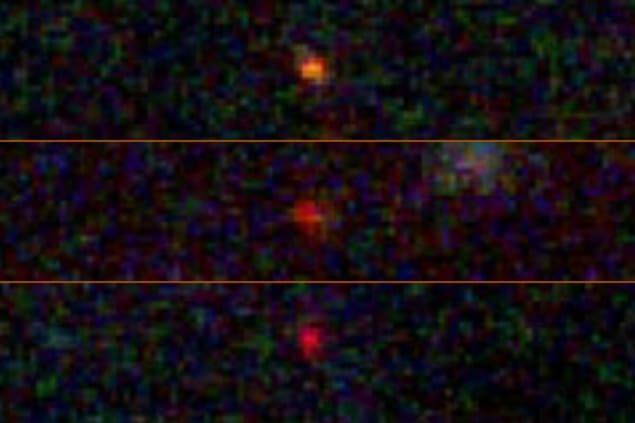Stars powered by dark matter may have been seen by the JWST
01 Aug 2023
Dark stars, not galaxies: these three objects were originally identified as galaxies by the JWST Advanced Deep Extragalactic Survey. Now, however, a trio of astronomers argues that they are actually supermassive dark stars. (Courtesy: NASA/ESA)
A trio of US astronomers has found compelling evidence for the existence of “dark stars” – hypothetical objects powered by the annihilation of dark matter. Dark stars could explain the unexpected abundance of ancient galaxies seen by the James Webb Space Telescope (JWST). Katherine Freese at the University of Texas, Austin along with Cosmin Ilie and Jillian Paulin at Colgate University used JWST data to conclude that three of these galaxies may actually be dark stars.
Less than two years since its first images were released, JWST has already changed astronomers’ understanding of the early universe. Among its most surprising observations has been the sheer number of extremely bright, ancient galaxies, which would have formed in regions rich in dark matter.
Dark matter is a hypothetical substance that is invoked by physicists to explain the large-scale structure of the universe. While it has never been observed directly, it is a part of the current standard model of cosmology – the lambda cold dark matter model (ΛCDM). This describes the structure and expansion of the universe, while accounting for the gravitational influence of dark matter.
Dark matter heating
In 2007, Freese and colleagues proposed the possibility of “dark stars”, which may have been common in the early universe. While composed mostly of hydrogen and helium, these exotic stars would be fuelled by “dark matter heating” rather than nuclear fusion. This could involve a type of dark matter called weakly interacting massive particles (WIMPs). WIMPs have evaded discovery for decades in Earth-based detection experiments, but according to Freese’s team, the sheer density of dark matter in the early universe could cause them to interact far more frequently with regular matter during the formation of some of the earliest stars.
In the early universe, “WIMPs could have annihilated into photons, electron-positron pairs, and other particles, which collided with the hydrogen in collapsing clouds,” Freese explains. “These particles then get stuck inside the cloud, and deposit all the energy from the mass of the dark matter particles into the cloud. The cloud then stops collapsing, and instead turns into a ‘dark star’.”
Dark stars are stars in every sense, in that the immense gravity of their cold, infalling material is perfectly balanced by outward hydrostatic pressure, generated by energy-releasing processes in their interiors. All the same, Freese says that they have several key distinctions from regular stars.
Cool throughout
“They have no cores, unlike fusion powered stars, which need high temperatures in order for fusion to take place,” Freese explains. “Dark stars are cool throughout, including at the surface, so that they do not produce ionizing photons or winds that would prevent them from accreting mass.”
As a result, Freese and colleagues argue that dark stars balloon in size to some 10 AU, and millions of solar masses. This allows the stars to pull in even more particles of dark matter. In the process, a “supermassive” dark star (SMDS) may become bright enough to outshine an entire galaxy.
Ordinarily, galaxies can be easily distinguished from stars since they take up extended regions of space, whereas stars appear as single points of light. Yet at such vast distances, even JWST does not have a high enough resolution to distinguish between stars and galaxies. If Freese and her colleagues are correct, this would suggest that ancient galaxies appear so numerous in JWST’s data because many of them are SMDSs.
Absorption lines
To search for evidence of SMDSs, the trio examined data from the JWST Advanced Deep Extragalactic Survey (JADES). In the survey, they looked for evidence of light at certain wavelengths being absorbed by candidate stars. In particular, they were interested in the 1640 nm helium-II absorption line which is often observed in the spectra of hot, bright stars.
“A helium-II absorption line would be a smoking gun for a dark star, as galaxies would not produce such lines,” Freese says. “If elements other than hydrogen and helium are found, then it’s not a dark star.”READ MORE

As they searched with JADES, they identified several objects that closely matched their SMDS criteria. “We found that three of them are good matches to SMDSs,” Freese continues. “They have the right spectra, although the resolution of the detector can’t yet tell whether these are point or extended objects.”
In the future, the team hopes JWST will pick up SMDS candidates that have been magnified by gravitational lensing – which may boost resolution high enough to confirm that the objects are indeed single points of light, rather than extended galaxies. “If some of these early objects are dark stars instead of galaxies, that would help maintain the consistency of JWST’s observations with the standard model of cosmology,” Freese says.
On top of this, this confirmation could be a major breakthrough in our understanding of the nature of dark matter, and provide further evidence for the existence of WIMPs.
The research is described in the Proceedings of the National Academy of Sciences.
Sam Jarman is a science writer based in the UK
FROM PHYSICSWORLD.COM 2/8/2023

Δεν υπάρχουν σχόλια:
Δημοσίευση σχολίου